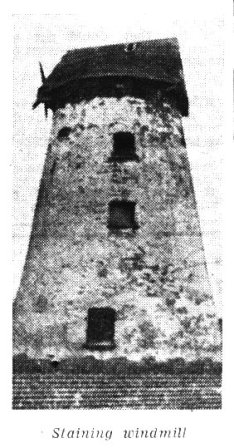Newspaper cutting from about 1965
Hardhorn-with-Newton
FYLDE'S MOST COSMOPOLITAN VILLAGE
ALTHOUGH the parish of Hardhorn-with-Newton may be only 10
minutes by car from the Golden Mile and many of its residents have roots in
Blackpool it is a quiet place with a character all its own.
In winter the village nestles quietly amid snow-clad fields off
the Preston New-road and in summer comes to life when more than 1,000 holidaymakers
fill the 500 caravans occupying 10 sites in the parish. Hardhorn-with-Newton
stepped into the headlines recently as a result of Blackpool's take-over bid for
the northern 29 acres of the parish adjoining the Normoss part of Poulton.
Opposed
This area has a total of 324 residents and a rateable value of
nearly £3,000, figures which comprise nearly a third of the parish's total rateable
value and more than a third of the population. The local parish council and Fylde
Rural District Council decided to oppose the take- over after a referendum taken
among ratepayers in the area which would be affected showed 29 in favour of joining
Blackpool and 57 against.
Hardhorn-with-Newton, the 1,396 acres of which have a rateable
value of £9,359 and a population of about 800, is probably the most cosmopolitan
parish in the Fylde. Its population is made up of farmers and other residents who
may have lived in the area all their lives, of retired people from inland towns in
East Lancashire and Yorkshire, and of office and factory workers who travel to
Blackpool to work. Many of the latter live in the “take-over" area at the north end
of the parish. This is the area where many of the newer homes of the parish are to
be found.
The village
 But it is in Staining
village, the centre of the parish, that most of the older residents arc to be
found. Here one can see an ancient windmill, old cottages, some of which began
their lives as tithe barns, and the old village church and school. The mission
church is 100 years old in 1965. A school was included in the church buildings
after it was built. But there were homes in Staining long before the church
was built. But it is in Staining
village, the centre of the parish, that most of the older residents arc to be
found. Here one can see an ancient windmill, old cottages, some of which began
their lives as tithe barns, and the old village church and school. The mission
church is 100 years old in 1965. A school was included in the church buildings
after it was built. But there were homes in Staining long before the church
was built.
The village pub "The Plough", where you'll meet licensee Mr
Harry Goddard, a former member and Chairman of the parish council, has a licence
which dates back to 1810. First a licensed farmhouse catering for the coaching
trade, the house later became an inn. From school teachers to farmers and
businessmen to poultrymen, the membership of the parish council indicates the
cosmopolitan nature of the residents.
Woman Chairman
Chairman is Coun Mrs Catherine Hawthornthwaite, of Willow Bank
Staining, the first-ever woman Chairman of the council and a native of Kent who
married a local farmer, Coun Clifford Stott of East View, Castle-lane, Staining, a
civil servant at Preston has lived in the village for nearly 25 years. In addition
to the parish council he has been a member of the Fylde Rural District Council
since 1960.
The "father” of the parish council is businessman Coun Charles
Eddlestone, of Willow-Bank, Staining, and other members are Coun James Moon, of
Staining-road, Staining, a market gardener and poultryman, Coun J. McLaren, a fire
service employee, of Whalley-crescent, Staining, Coun Mrs Beatrix Dixon, of
Chain-lane, Staining, a teacher at the Staining Church of England school, Coun Bert
Feecham, a farmer, of Church Farm, Staining, Coun James Parkinson, County . Council
Highways department foreman. of Staining-road. Newton, and Coun Hume, a caravan
site operator of Willow Bank, Staining.
New homes
At the moment the rural district council is preparing a scheme
for the erection of 24 homes including eight old people's dwellings at Chain-lane,
Staining, which along with any private development should bring the parish
population to about 1,000 in the next year or so.
Newspaper cutting from about 1965
|